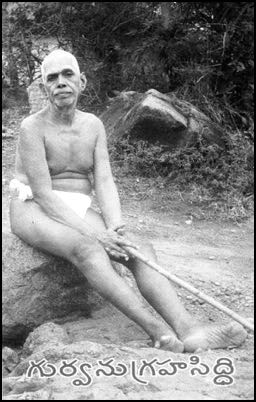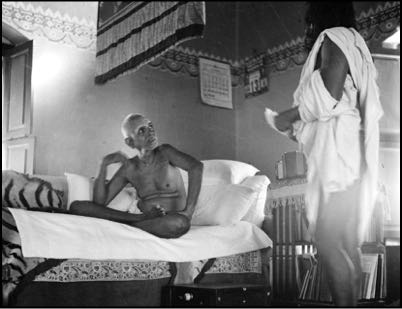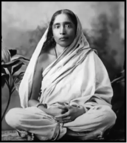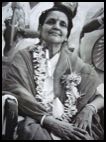Spiritual-Teaching.org
How do we direct our attention to that which is vital to our well-being and may offer an antidote to our confusion and suffering? We can focus on a train of thought that leads us to an insight, if we are that way endowed with sustained logical ability. Another way is to direct our attention to an image and learn as much as we can by accumulating knowledge about it.
Think of an image of a loved one which brings with it a welter of impressions that sustains us emotionally and satisfies us intellectually.
Now that Sri Ramana is no longer available in a physical body we think of him by engaging a photograph or an anecdote from numerous accounts of those with him during his earthly sojourn. Or his teachings both in prose or poetry. Rarely is there a dream in which he appears but it does happen. Inevitably, ‘our’ image of Bhagavan Ramana has changed over decades with the evolution of the ideas about the historical Sri Ramana and the personal image which has evolved in our hearts and heads. Everyone has their ‘own’ Sri Ramana, and all are true. How devotees saw him in the 1940s is not necessarily the same as how people ingeneral today view him. Perceptions have changed.
When I first came to the ashram many who were fortunate enough to experience his presence were still alive and happy to speak about him, and invariably they would do so with a sparkle in their eyes and a lightness of spirit. I remember the first time I attended the Jayanthi (birthday) celebrations, the day’s activities culminated in a film show after supper.
In those days, winter at the ashram was frosty in the mornings and evenings. It was cold and people were wrapped up warm as we sat patiently while each reel was threaded through the antiquated projector. Appachi, one of the two main ashram priests, was in charge of the archaic machine carefully brought out of storage along with the reels from the days when Bhagavan walked the ashram. There was a family-feeling in the air after most of the guests and outside devotees had left by the late afternoon. Ramana Nagar in the 1970s still retained a rustic, innocent atmosphere.
The first reel showed Arunachala, with Ma Taleyarkhan and Sunna Framji expectantly standing on a lower slope facing Arunachala when Bhagavan suddenly appeared like a king from over the ridge. There was a noticeable intake of breath among the audience at the sight as if a smiling, divine being had revealed himself. That a clunky reel with patchy spots on the aged contraption could elicit such a sense of reverence and awe was remarkable.
We waited patiently as each new spool was threaded. There were some five or six that we happily watched with no less excitement and wonder. We were in heaven.
Nowadays at the press of a computer button, we can see the same reels in a single continuous restored display, and although there is some slight frisson, it is difficult to experience that same restrained joy that pervaded the Samadhi Hall of devotees secure in a cocoon of common devotional glow. This is inevitable for repetition dilutes the initial cutting-edge happiness. Yes, one can explain that familiarity diminishes the excitement but I feel it is more than that. Unconsciously we take it for granted. And with familiarity can grow a certain condescension. Like poor, little rich kids we are tempted as in Oscar Wilde’s remark, “The cynic knows the price of everything and the value of nothing.”
How does one not fall into that trap of taking for granted what is now so readily available? One way to keep the flame alive is to start at zero each day. But that requires a degree of humility few of us understand. Life certainly helps by throwing us shocks or unanticipated events that jar our shallow equilibrium and make us realise, if only for a moment, that our sense of complacent certainty is a myth. There is nothing so dull as a closed mind. We can never be sure of anything and when we realise this, we haltingly at first, begin to live in the moment.
As the years go by and the years of Bhagavan’s earthly life become more distant, those who regard Bhagavan Ramana as their guiding light, have entered a new phase where our relationship with him is as much connected by memory as by a living presence. Parallel to this is the growing literature ‘explaining’ Bhagavan to us. Some of it is helpful and some is irrelevant and worse, misinformed, however well-intentioned. From a simple, open field with clear directions and landmarks, we are now entering a thick forest of verbiage.
Then how do we avoid this snare of taking Bhagavan Ramana for granted or being deluded by a superficial consideration that is narrow at best? It is by establishing a personal relationship. All who are sincere devotees have a personal relationship with whom we call Sri Ramana Maharshi. I often wondered while gazing at the Samadhi of Sri Ramana as the crowds mingle in front and around the shrine, how each one is directly connected with that Presence. 1 It is like an assemblage of pulsations fixated on a living hub. How can that centre be aware of them all? This sounds bizarre but I am unable to illustrate in any other way the continuous miracle of the Presence which spontaneously responds, or deliberately not to our prayers, thoughts and emotions in all their positive and negative diversity. Sometimes the Presence is like a stone, hard and unyielding but that too is an intentional response. It means that one should reconsider and ask why there is no reciprocity. absolutely I found in the literature about Lord Krishna, notably the Bhagavata Purana, a ‘fact’ that he had an individual relationship as a youth and cowherd with the 16,000 gopis, each of whom played with him in the forests of Vrindavan. I put it down to a fertile poetic imagination but not anymore, because my relationship with Sri Ramana Maharshi shifted at some point from a static connection to one that is direct and alive. But this is not unique. It is the experience of many who have surrendered to that higher power we call Sri Ramana. Back in the 1980s, a visitor from an ashram that was a controversial and by extension, an exciting place, remarked that Sri Ramanasramam was a rather boring place for many of its inhabitants were so inward-turned and monotonous. This is true because we are overwhelmed by the quality of peace that pervades the ashram and is noticeable from the moment one enters thegates. Like planets, we are attracted and consumed by a sun whose magnitude defies our conception.
It is all a question of being alert. Admittedly it is harder these days with so many new arrivals who heard of Sri Ramana and Arunachala but nonetheless, it is there.
And for those who cannot come at least once to the ashram, a new phenomenon is slowly arising where it is no longer necessary to be physically present. Just as in this modern age with the internet and instant communications, it matters less and less where one lives in this world. We all are connected. The recent COVID pandemic is indicative of the change and we hear more and more from people, that they are touched and sustained without moving from their home. Just to think of Sri Ramana is a potential gateway that can open up an extraordinary availability of grace.
Sri Bhagavan’s authority is elusive and cannot be catalogued but indubitably it is there. It is self-evident to anyone who has had an epiphany connected with Sri Ramana. And for us, this is all that matters because understanding Sri Ramana is not a question of books, lectures or photographs, it is rather one of a direct immediate relationship that feeds one’s soul and elevates it beyond the crushing burden of endless identification with thoughts, desires, fears. We all yearn to stand on a mountaintop and breathe the clean, exultant air free from compulsion.
___________________________
1 In Sanskrit, Samadhi, means nearness or proximity
Letter # 19 - Bhagavan Sri Ramana Maharshi: The Person





